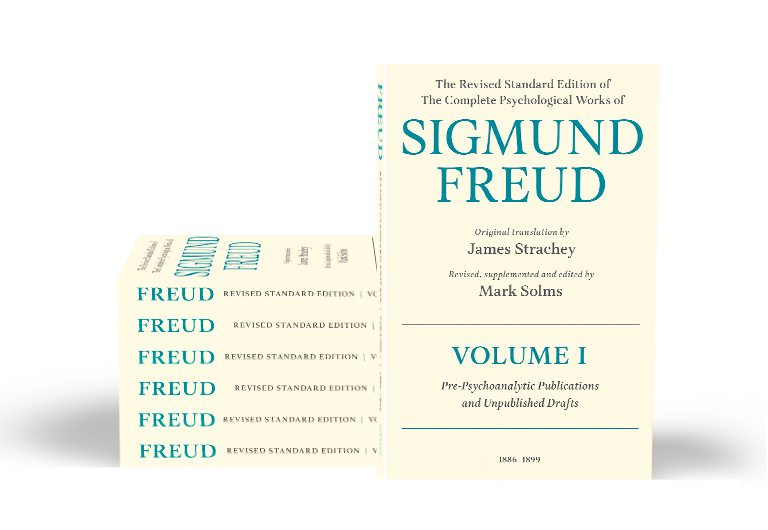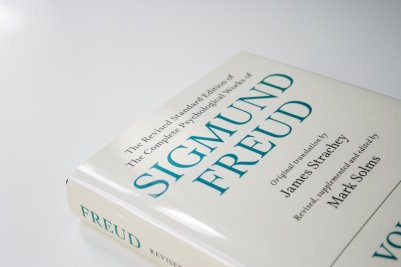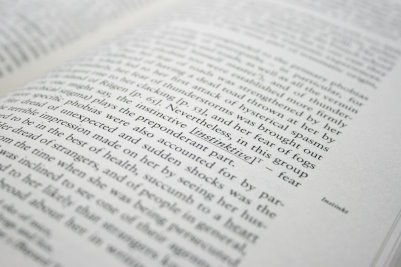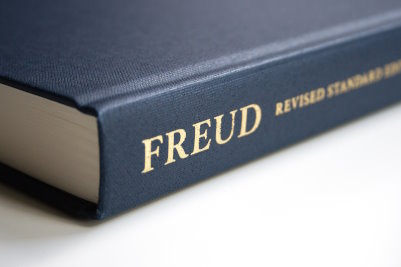The Revised Standard Edition of the Complete Psychological Works of Sigmund Freud
With this landmark 24-volume set, Mark Solms revises and enriches Strachey’s translation of Freud’s works and delivers the new academic and professional standard, and the future of Freud.
June 20248,144 pages24-volume hardback set with dustjackets
9781538175163
The long-awaited Revised Standard Edition of the Complete Psychological Works of Sigmund Freud preserves the original Standard Edition translation from the German by James Strachey, while adding a new layer of revisions and translations with explanatory annotations under the executive editorship of neuroscientist, psychoanalyst, and Freud scholar Mark Solms. The Revised Standard Edition also presents material not previously translated into English, including 56 lectures, drafts, letters, forewords, and other works of interest.
This ground-breaking update of the Standard Edition—which was first published 60 years ago—revises errors and mistranslations while retaining the original translation for comparison. To preserve the historical—and at times controversial—translation and commentaries from James Strachey’s version, a subtle underlining distinguishes Mark Solms’s revisions and additions in an easy and accessible way, highlighting where there are differences from the old Standard Edition. Readers can examine what Strachey contributed before the revisions, in tandem with Solms’s updates, retranslations, and notes which bring Freudian material into dialogue with the most recent 21st-century developments in the field.
Commissioned by the British Psychoanalytical Society and co-published by Rowman & Littlefield, the 24-volume Revised Standard Edition brings together decades of scholarly deliberation concerning the translation of Freudian technical terms while retaining the best of Strachey’s original English translation. This landmark work will captivate a wide audience, from interested lay readers to practicing clinicians to scientists and scholars in fields related to psychoanalysis.

The RSE is a work of immense historical, theoretical, clinical, and cultural value to scholars, practitioners, students, and the general public. Solms has meticulously reviewed SE language for errors, set in context complex meanings of technical terms, and provided end notes that expand and update the understanding of original texts. This monumental editorial revision brilliantly illuminates the roots and meanings of Freud’s thinking.
Harriet L. Wolfe, MD Clinical professor of psychiatry and behavioral science, University of California San Francisco; president, International Psychoanalytical Association
Volume Titles
-
Volume I: Pre-Psychoanalytic Publications and Unpublished Drafts 1886–1899
Volume I documents the pivotal period in Freud’s life when his interests diverged from neurology to psychology, via unpublished drafts and early publications. This volume begins with Mark Solms’s general preface to the Revised Standard Edition as a whole. The centrepiece of the volume is provided by extracts from Freud’s correspondence with Wilhelm Fliess, including the “Project for a Scientific Psychology”— thoroughly re-edited for the RSE. This volume includes a previously unpublished lecture by Freud on hypnosis and suggestion, and two book reviews by him not included in the Standard Edition.
-
Volume II: Studies on Hysteria (Josef Breuer and Sigmund Freud) 1893–1895
Volume II contains the Studies on Hysteria, which is often regarded as the starting point of psychoanalysis. It presents a series of case histories, including the seminal treatment of Anna O. under Josef Breuer’s care. Breaking from the standard protocols of hydrotherapy, electrotherapy and hypnosis, Freud and Breuer turned to the cathartic method with great success. The Studies sees their discovery and exploration of the unconscious mind through this early version of the “talking cure.” This volume includes a case study which was not included in the Standard Edition (Nina R.) and two reports of a previously unpublished lecture by Freud on the topic of hysteria.
-
Volume III: Early Psychoanalytic Publications 1893–1899
Volume III presents Freud’s early nosological writings and his pioneering studies concerning the sexual aetiology of the neuroses. Landmark papers in this volume include “The Neuropsychoses of Defence,” “Obsessions and Phobias,” “Heredity and the Aetiology of the Neuroses,” and “The Aetiology of Hysteria.” This volume of the Revised Standard Edition includes a lecture on obsessional ideas and phobias, and two book reviews by Freud—on the sexual drive and migraine, respectively—which were unknown at the time of the publication of the Standard Edition.
-
Volume IV: The Interpretation of Dreams (First Part) 1900
Volume IV contains part one of The Interpretation of Dreams, a major classic in scientific history. Here, Freud reviews the world literature on dreams and comes to the conclusion that they are valid psychological acts, with purpose and meaning. Through a deep analysis of his own dreams, he concludes that every dream is an attempt to fulfill a repressed infantile wish, and thereby to protect sleep. In this volume, we see Freud’s first description of “dream work,” which includes such fundamental processes as condensation, displacement, and regression. This description lays the groundwork for Freud’s fundamental model of the mind, which he sets out in the second part of this work. The Revised Standard Edition of the present volume is a substantial updating of the editorial apparatus, including a discussion of the phenomenon of REM sleep.
-
Volume V: The Interpretation of Dreams (Second Part) and on Dreams 1900–1901
Volume V contains part two of The Interpretation of Dreams, a major classic in scientific history. In this section Freud outlines his theory of “dreamwork” and its implications for psychology in general. On this basis he proposes his first metapsychological model of the mind: the so-called topographical model. This volume of the Revised Standard Edition includes ‘On Dreams,’ considered by Freud himself to be a more accessible distillation of the material presented in The Interpretation of Dreams, as well as a memorandum on the characteristics of his own typical dreams which was discovered after the publication of the Standard Edition. Volume V concludes with an updated bibliography and index of Freud’s masterwork.
-
Volume VI: The Psychopathology of Everyday Life 1901
Volume VI introduces readers to Freud’s novel concept of parapraxis. The Psychopathology of Everyday Life shows how lapses —like forgetting and slips of the tongue—can provide clues about our hidden desires and intentions. This volume contains an amusing illustration from a letter by Freud to his then-fiancée Martha Bernays, wherein inkblots formed by a slip of his pen led him to suggest that they might have been a product of jealousy. This is the first recorded interpretation of a “Freudian slip.” As with the whole of the Revised Standard Edition, this volume includes a thoroughly updated editorial apparatus.
-
Volume VII: A Case of Hysteria, Three Essays on Sexuality and Other Works 1901–1905
Volume VII contains the landmark Three Essays on the Theory of Sexuality, wherein Freud formulates an entirely novel conception of human sexual development and behaviour. The volume opens, however, with another, equally momentous work: ‘Fragment of an Analysis of a Case of Hysteria.’ This was Freud’s first full-length report of a case of psychoanalytic treatment, in which he developed his theory of transference. This volume also includes several previously unpublished literature reviews, and statements on marriage law reform and homosexuality, which reveal Freud’s views on these topics to be far more progressive than previously realised.
-
Volume VIII: Jokes and their Relation to the Unconscious 1905
Volume VIII builds upon Freud’s earlier exploration of the hidden meaning of dreams and of parapraxes, with Jokes and Their Relation to the Unconscious. Divided into three parts—Analytic, Synthetic and Theoretical—this classic work was spurred by Fliess, who complained that the dreams which Freud analysed contained too many jokes. For the founder of psychoanalysis, this link between dreams and jokes demanded an explanation, one that he had in fact begun exploring even before Fliess’s letter. This volume of the Revised Standard Edition illustrates and addresses the inherent difficulties of translating jokes, puns, idioms and the like from one language to another.
-
Volume IX: Jensen’s ‘Gradiva’ and Other Works 1906–1909
Volume IX begins with a correction to the longstanding notion that Jung was the catalyst of Freud’s interest in Jensen’s Gradiva. His famous essay on this work presents not only an interpretation of the dreams of the novella’s main character but also a semi-popular account of Freud’s theory of the neuroses in general and of the therapeutic action of psychoanalysis. A second edition postscript follows. Further shorter essays in this volume include “Psychoanalysis and the Establishment of the Facts in Legal Proceedings,” “Creative Writers and Daydreaming,” “Some General Remarks on Hysterical Attacks,” and “Family Romances.” New to this edition is the thoroughly updated editorial apparatus.
-
Volume X: Two Case Histories (‘Little Hans’ and the ‘Rat Man’) 1909
Volume X contains two of Freud’s best-known case studies, those of “Little Hans” and the “Rat Man.” More formally entitled “Analysis of a Phobia in a Five-Year-Old Boy,” the first case report concerns a little boy who developed a fear of horses, which Freud interpreted as standing for the boy’s father. The historical importance of the case provides the first direct observation of the development of the Oedipus complex in a child, something that had previously only been reconstructed from adult cases. In “Notes Upon a Case of Obsessional Neuroses,” the patient came to Freud with serious obsessive-compulsive thoughts and behaviors specifically relating to his dead father and to a female friend (later his wife). It was notably the first full report of a case in which Freud considered a treatment using the psychoanalytic method to be a success—a triumph that would later be disputed. The present edition provides detailed new biographical information about these two cases.
-
Volume XI: Five Lectures on Psychoanalysis, Leonardo da Vinci and Other Works 1910–1912
Volume XI contains Freud’s celebrated Clark University lectures from 1909-1910, as well as a new preface to the Italian translation and a list of expository works. Also new to this edition is a review of Greve’s “On the Psychology and Psychotherapy of Certain Anxiety States” and several new editorial details concerning Freud’s “Leonardo Da Vinci and a Memory of his Childhood.” Shorter works in this volume include the groundbreaking series of papers entitled Contributions to the Psychology of Love and “The Psychoanalytic View of Psychogenic Disturbance of Vision.” Several other letters and reviews round out the volume.
-
Volume XII: The Case of Schreber, Papers on Technique and Other Works 1910–1914
Volume XII begins with the dramatic case study of Schreber, a distinctive work within Freud’s oeuvre. An analysis of the memoirs of a highly-regarded German judge, this paper studies Schreber’s deep psychosis, revealing that even serious psychiatric illness can be understood psychoanalytically. This edition of the celebrated case study incorporates interesting new information about the patient, gleaned from the past several decades of Freud scholarship. In addition to Freud’s canonical papers on technique—the editing of which has been updated here—the volume concludes with a previously unpublished short paper entitled “More Children.”
-
Volume XIII: Totem and Taboo and Other Works 1913–1914
Volume XIII begins with the controversial Totem and Taboo, a collection of four essays inspired by the work of Wundt and Jung. Long interested in anthropology and archaeology, Freud’s “The Taboo of Incest” concerns the totemic practices of aboriginal cultures; “Taboo and Emotional Ambivalence” explores projection as it relates to totems within cultures; “Animism, Magic and the Omnipotence of Thought” discusses the projection of the inner mental world of ‘primitive’ peoples onto their culture; “The Return of Totemism in Childhood” is an extended meditation on one of Darwin’s theories, in which Freud extrapolates that all religion is based on a singular moment of guilt and original sin—fratricide within the primal family. This volume also includes a new appendix: Freud’s essay comparing the neurotics he treated in Vienna with the ‘savages’ of older cultures, as well shorter writings on the psychoanalytic method in relation to scientific enquiry, philosophy, art and the clinical observation of patients.
-
Volume XIV: On the History of the Psychoanalytic Movement, Papers on Metapsychology and Other Works 1914–1916
Volume XIV opens with “On the History of the Psychoanalytic Movement.” By the time of its writing in 1914, Freud had split with Jung and Adler, despite both of the latter still claiming that their theories were psychoanalytical. Therefore, Freud set out in this work to plainly describe his psychoanalytic method in its own fundamentals and postulates, showing how Jung’s Analytical Psychology and Adler’s Individual Psychology diverge from it, and arguing that to designate all three theories as ‘psychoanalysis’ was far too confusing. This polemical essay is followed by “On Narcissism” and Freud’s celebrated “Papers on Metapsychology,” with special interest in this volume focusing on a previously missing paper from the series: “Overview of the Transference of Neuroses.” The volume closes with a collection of shorter writings from 1915-1917.
-
Volume XV: Introductory Lectures on Psychoanalysis (Parts I and II) 1915–1916
Volume XV contains Parts I and II of the Introductory Lectures on Psychoanalysis, extensively corrected and revised for this Revised Standard Edition, along with two new prefaces. The most circulated and translated of all Freud’s works, the Introductory Lectures were based on talks given by him at the University of Vienna from 1915-1917. The casual format of these Saturday lectures appealed to Freud, as he could engage in lively dialogue with his audience. As Europe was engulfed in the protracted First World War, Freud’s clinical work had taken a back seat in favour of the consolidation of his theoretical enquiries, and the success of that process of consolidation is well illustrated by the popular lecture series. Included in this volume are “Parapraxes” and “Dreams,” along with a new bibliography and frontispieces.
-
Volume XVI: Introductory Lectures on Psychoanalysis (Part III) 1916–1917
Volume XVI contains the final Part III of the Introductory Lectures on Psychoanalysis, extensively corrected and revised from the original Standard Edition version. The most circulated and translated of all Freud’s works, the Introductory Lectures are based on talks given by him at the University of Vienna from 1915-1917. The format of these Saturday lectures appealed to Freud, as he could engage in lively dialogue with his audience. As Europe was engulfed in the protracted World War I, Freud’s clinical work had taken a back seat in favour of the consolidation of his theoretical enquiries, and that process of consolidation is well illustrated by the popular lecture series. “General Theory of the Neuroses” includes discussion of the more common of the human condition, such as libido, anxiety, and sexual development, as well as more narrow symptoms more closely related to psychosis, such as paranoia, repression, and trauma fixation.
-
Volume XVII: An Infantile Neurosis and Other Works 1917–1919
Volume XVII updates the famous case study of the “Wolf Man,” on the basis of the considerable amount of Freud scholarship that has occurred in the years since its publication in the original Standard Edition. Several important biographical elements of the subject have been included here for the first time. Under Freud’s care from 1910-1914, the case of this wealthy Russian patient was held back from publication for several years by Freud himself, since he was doubtful about some of the patient’s stories from his childhood. Rounding out this volume are several writings on topics ranging from transformations of drive in anal eroticism, the war neuroses, and a previously unpublished original version of the essay “Should Psychoanalysis be Taught at Universities?”.
-
Volume XVIII: Beyond the Pleasure Principle, Group Psychology and Other Works 1920–1922
Volume XVIII opens with the highly regarded work Beyond the Pleasure Principle. Freud explores the ‘repetition compulsion’, our drive to mentally return to events both real or imagined as a way to come to terms with moments of guilt, pain, trauma or, of course, pleasure. With this exploration of mental events, Freud felt compelled to revisit and revise his original drive theory, and with it arrived at a robust teleology of the drives underpinning mental life. The volume continues with a slightly revised translation of Freud’s ‘Group Psychology and the Analysis of the Ego’, which concerned his belief that our individual and social drives are intimately connected. Rounding out this volume are several shorter case studies and papers, encyclopedia entries and, most notably, a revised version of ‘Psychoanalysis and Telepathy’ — with previously deleted passages included.
-
Volume XIX: The Ego and the Id and Other Works 1923–1925
Volume XIX contains one of Freud’s most enduring works, The Ego and the Id, a robust revision of his topographical model of the human psyche and the development of his later structural model of the mind in subsequent psychoanalysis. Freud explores the internal tensions between the ego and id, the ego and superego and the life and death drives, all of which are at odds with his earlier distinctions between consciousness and unconsciousness. The internal and external forces that give rise to the superego have a powerful effect on the ego, leading to shame and guilt. The volume continues with works on dream interpretation, masochism, neurosis and psychosis, the Oedipus complex and an exploration of Freud’s interest in witchcraft and possession in the short work ‘A Seventeenth-Century Demonological Neurosis’.
-
Volume XX: An Autobiographical Study, Inhibitions, Symptoms and Anxiety, The Question of Lay Analysis and Other Works 1925–1926
Volume XX begins with ‘An Autobiographical Study’, a work that is not in fact an autobiography of Freud alone but rather an overview of his decades of work in the development of psychoanalysis, and a reflection on his journey from a career as a neurologist to that of a psychoanalyst. His father Jakob’s presence looms large, and the personal recounting of Freud’s path makes it clear that the relationship was a close, if tangled one. The works which follow are ‘Inhibitions, Symptoms and Anxiety’, and ‘The Question of Lay Analysis’, The latter is presented here with three appendices that were unknown at the time of publication of the Standard Edition. Shorter writings conclude the volume, including a moving eulogy to Karl Abraham, as well as an appreciative note to Romain Rolland on his birthday.
-
Volume XXI: The Future of an Illusion, Civilization and its Discontents and Other Works 1927–1931
Volume XXI contains eight works that did not appear in the Standard Edition, including letters to Albert Einstein, Georg Fuchs and Julius Tandler. Additionally, there is a new appendix, ‘Appreciation of Max Eitingon’. The volume opens with Freud’s discussion of religion, ‘The Future of an Illusion’, in which he provides a psychoanalytic viewpoint of religion as a questionable belief system, moving from illusion to delusion. ‘Civilization and Its Discontents’ analyses the universal problems of human suffering, claiming that civilizations can only progress if they suppress our innate drives. This volume contains his classic paper on fetishism, plus shorter writings on humour, sexuality, libido and Freud’s musings on the works of Dostoevsky and Descartes.
-
Volume XXII: New Introductory Lectures on Psychoanalysis and Other Works 1932–1938
Volume XXII begins with Freud’s 1932 famous New Introductory Lectures on Psychoanalysis. These seven lectures are best understood as supplements to his previous Introductory Lectures, as some are a distillation of existing ideas on miscellaneous topics while others introduce entirely new metapsychological and theoretical discussions. This is followed by Freud’s previously distorted introduction and chapter contributions to a controversial biography of Woodrow Wilson, none of which appeared in the old Standard Edition. The volume continues with numerous shorter writings, including several previously unknown letters, introductions, prefaces and a ‘Letter on Homosexuality’ to a patient’s mother, displaying a far more nuanced, tolerant and (for its time) radical viewpoint than has previously been attributed to Freud.
-
Volume XXIII: Moses and Monotheism, An Outline of Psychoanalysis and Other Works 1937–1939
Volume XXIII opens with one of Freud’s more controversial books, Moses and Monotheism, which would also become his final major work. An early version was written in 1934, but unpublished due to concerns about the response from the Catholic Church. It was finally published in the shadow of World War II and amidst Freud’s exile in London. Taken together, the three essays assert that Moses was Egyptian royalty, murdered by his followers and that their repressed collective guilt over this act led to a recommitment to biblical monotheistic religion. An Outline of Psychoanalysis follows, also written during Freud’s time in London. The truncated nature of this expository work has led many over the years to wonder if the Outline was meant to be published at all, as it can be properly understood only by readers with a deep knowledge of psychoanalysis. The final shorter writings of this volume cover the years 1937 to 1939, including letters written during his last days in Vienna and in London, during a time of great upheaval and ill health.
-
Volume XXIV: Translation Notes, Indexes and Bibliographies
Volume XXIV is a major scholarly work in its own right, and entirely different from previous edition. It includes not only a composite index of all the works in the Revised Standard Edition but also a comprehensive discussion of the translation of Freud’s technical terms and of numerous associated controversies relating to specific passages, phrases and terms within his oeuvre. In addition, this volume lists all the new Freud material in the RSE, relocated material, illustrations, abbreviations and editorial annotations. Finally, it includes a fully updated bibliography of all of Freud’s published works, including posthumous publications and hundreds of titles which were not included in the original catalogue of Freud’s complete works in the old Standard Edition.
About the editor

Mark Solms
Psychoanalyst & Neuropsychologist
Mark Solms is a globally acclaimed psychoanalyst and neuropsychologist, known for the integration of contemporary
neuroscience with psychoanalytic methods and theories, and for his discovery of the forebrain mechanisms of dreaming.
He is the Director of Neuropsychology at the University of Cape Town and Groote Schuur Hospital, the Science Director of the American Psychoanalytic Association, and the Co-Chair of the International Neuropsychoanalysis Society.
About IOPA

Founded in 1913, the British Psychoanalytical Society is home to an international community of professionals dedicated to helping people
enhance their lives through psychoanalysis. Past members of the Society include some of the most important figures in the history
of psychoanalysis—Michael Balint, Wilfred Bion, John Bowlby, Anna Freud, Melanie Klein, Joseph Sandler, Hannah Segal, and Donald Winnicott,
among others.
The Institute of Psychoanalysis is the outward face and training body of the British Psychoanalytical Society. As a Component Society of the International Psychoanalytical Association, the Institute of Psychoanalysis provides rigorous trainings in psychoanalysis with adults and with children, and also runs a range of conferences, lectures, and courses for mental health professionals, related disciplines, and the wider public, attracting audiences worldwide. The Institute’s extensive archives include a wealth of material relating to the history and clinical practice of the British Psychoanalytical Society, including letters and papers of a number of eminent psychoanalysts. The Institute oversees current scholarly outlets including the International Journal of Psychoanalysis and the New Library of Psychoanalysis book series.
The Revised Standard Edition of the Complete Psychological Works of Sigmund Freud
Orders submitted through this website are fulfilled by Ingram Publishers Services and shipped from the UK; the shipping cost from the UK is calculated at checkout. If you are ordering from outside the UK, please check our international sales representatives and distributors or contact Alex Kind at [email protected] for local ordering options.




